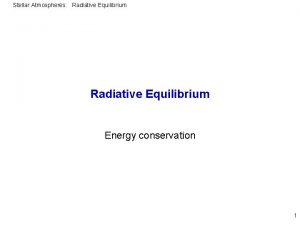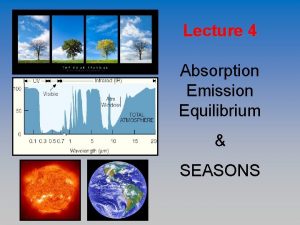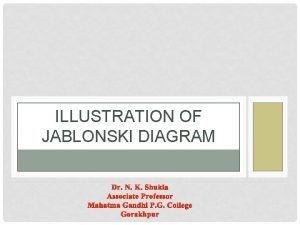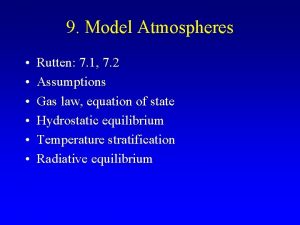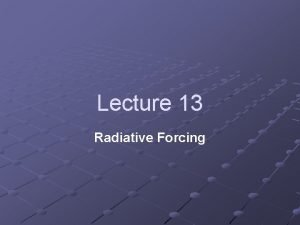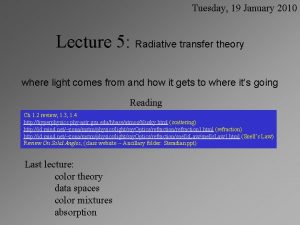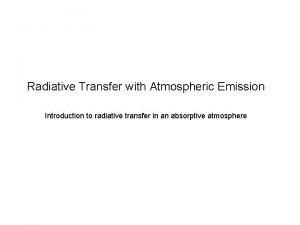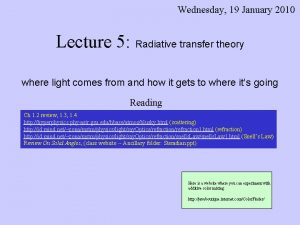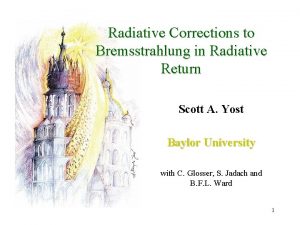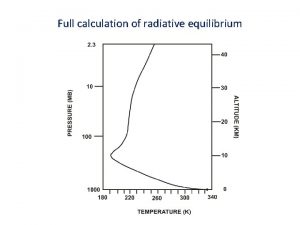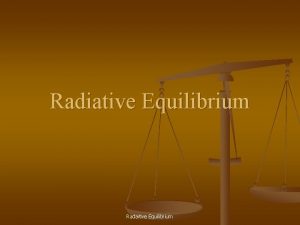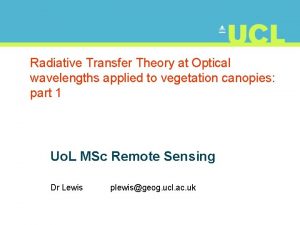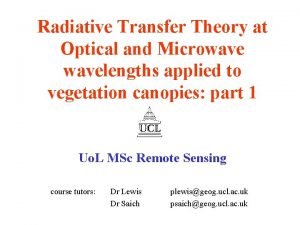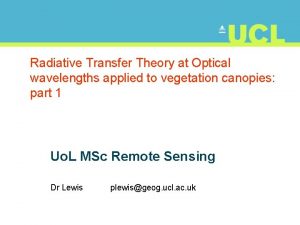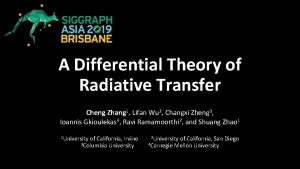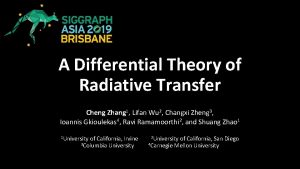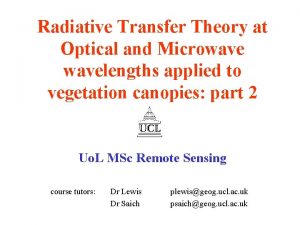Tuesday 20 January Lecture 5 Radiative transfer theory
















- Slides: 16

Tuesday, 20 January Lecture 5: Radiative transfer theory where light comes from and how it gets to where it’s going http: //hyperphysics. phy-astr. gsu. edu/hbase/atmos/blusky. html (scattering) http: //id. mind. net/~zona/mstm/physics/light/ray. Optics/refraction 1. html (refraction) http: //id. mind. net/~zona/mstm/physics/light/ray. Optics/refraction/snells. Law 1. html (Snell’s Law) Review On Solid Angles, class website (Ancillary folder: Steradian. ppt) Last lecture: color theory, data spaces, color mixtures, absorption, photogrammetry

The Electromagnetic Spectrum (review) Units: Micrometer = 10 -6 m Nanometer = 10 -9 m Light emitted by the sun

W m-2 μm-1 sr-1 W m-2 μm -1 Light from Sun – Light Reflected and Emitted by Earth Wavelength, μm


Atmospheric Constituents Constant Nitrogen (78. 1%) Oxygen (21%) Argon (0. 94%) Carbon Dioxide (0. 033%) Neon Helium Krypton Xenon Hydrogen Methane Nitrous Oxide Variable Water Vapor (0 - 0. 04%) Ozone (0 – 12 x 10 -4%) Sulfur Dioxide Nitrogen Dioxide Ammonia Nitric Oxide All contribute to scattering For absorption, O 2, O 3, and N 2 are important in the UV CO 2 and H 2 O are important in the IR (NIR, MIR, TIR)


Atmospheric transmission

Modeling the atmosphere To calculate t we need to know how k in the Beer-Lambert. Bouguer Law (called b here) varies with altitude. Modtran models the atmosphere as thin homogeneous layers. Modtran calculates k or b for each layer using the vertical profile of temperature, pressure, and composition (like water vapor). Fo is the incoming flux This profile can be measured made using a balloon, or a standard atmosphere can be assumed.

20 20 15 15 Altitude (km) Radiosonde data 10 5 0 0 20 40 60 80 100 Relative Humidity (%) 10 Mt Everest 5 Mt Rainier 0 -80 -40 0 40 Temperature (o. C)

Terms and units used in radiative transfer calculations 0. 5º Radiant energy – Q (J) - electromagnetic energy Solar Irradiance – Itoa(W m-2) - Incoming radiation (quasi directional) from the sun at the top of the atmosphere. Irradiance – Ig (W m-2) - Incoming hemispheric radiation at ground. Comes from: 1) direct sunlight and 2) diffuse skylight (scattered by atmosphere). Downwelling sky irradiance – Is↓(W m-2) – hemispheric radiation at ground Itoa L Ls↑ Path Radiance - Ls↑ (W m-2 sr-1 ) (Lp in text) directional radiation scattered into the camera from the atmosphere without touching the ground Transmissivity – t - the % of incident energy that passes through the atmosphere Radiance – L (W m-2 sr-1) – directional energy density from an object. Reflectance – r -The % of irradiance reflected by a body in all directions (hemispheric: r·I) or in a given direction (directional: r·I·p-1) Is↓ Ig Note: reflectance is sometimes considered to be the reflected radiance. In this class, its use is restricted to the % energy reflected.

Radiative transfer equation Parameters that relate to instrument and atmospheric characteristics DN = a·Ig·r + b This is what we want Ig is the irradiance on the ground r is the surface reflectance a & b are parameters that relate to instrument and atmospheric characteristics

Radiative transfer equation DN = a·Ig·r + b DN = g·(te·r · ti·Itoa·cos(i)/p + te· r·Is↓/p + Ls↑) + o g t e i r Itoa Ig Is↓ Ls↑ o amplifier gain atmospheric transmissivity emergent angle incident angle reflectance solar irradiance at top of atmosphere solar irradiance at ground down-welling sky irradiance up-welling sky (path) radiance amplifier bias or offset

The factor of p Consider a perfectly reflective (r=100%) diffuse “Lambertian” surface that reflects equally in all directions. 2 p p/2 ∫ ∫ L sin then cos irradiance d dw=p. L If irradiance on the surface is I , the from the surface is g 0 0 r·Ig = Ig W m-2. • Incoming directional radiance L at elevation angle is-2 isotropic The radiance intercepted by a camera would be r·Ig/p W m sr-1. • Reflected directional radiance L cos is isotropic The factor p is the ratio between the hemispheric radiance (irradiance) and the directional radiance. area of the sky hemisphere is 2 p sr (for a unit • Area of a unit. The hemisphere: radius). So – why don’t we divide 2 pbyp/22 p instead of p? ∫ ∫ sin Lambert d dw=2 p 0 0

Measured Ltoa DN(Itoa) = a Itoa + b Itoa Ltoa=te r (ti Itoa cos(i)) /p + te r Is↓ /p + Ls↑ Itoa cos(i) i Highlighted terms relate to the surface ti Ls↑=r Is↓ /p Ls↑ (Lp) te i e Ig=ti Itoa cos(i) Lambert Is↓ r reflectance r (ti Itoa cos(i)) /p reflected light “Lambertian” surface


Next lecture: Atmospheric scattering and other effects Rayleigh Scattering l>>d Mauna Loa, Hawaii
 Sunday, tuesday, january, saturday
Sunday, tuesday, january, saturday Radiative equilibrium temperature
Radiative equilibrium temperature Radiative equilibrium temperature
Radiative equilibrium temperature Jablonski
Jablonski Radiative equilibrium temperature
Radiative equilibrium temperature Radiative forcing definition
Radiative forcing definition 01:640:244 lecture notes - lecture 15: plat, idah, farad
01:640:244 lecture notes - lecture 15: plat, idah, farad Is a disturbance that transfers energy from place to place
Is a disturbance that transfers energy from place to place Natural language processing nlp - theory lecture
Natural language processing nlp - theory lecture Bayesian decision theory lecture notes
Bayesian decision theory lecture notes Bayesian decision theory lecture notes
Bayesian decision theory lecture notes Natural language processing nlp - theory lecture
Natural language processing nlp - theory lecture Monday tuesday wednesday thursday friday calendar
Monday tuesday wednesday thursday friday calendar Tuesday please
Tuesday please How does morrie feel about music
How does morrie feel about music Tuesday morning prayers
Tuesday morning prayers Feathered friend by arthur c clarke
Feathered friend by arthur c clarke

